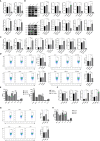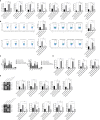The Recombinant E g.P29-Mediated miR-126a-5p Promotes the Differentiation of Mouse Naive CD4+ T Cells via DLK1-Mediated Notch1 Signal Pathway
- PMID: 35211114
- PMCID: PMC8861942
- DOI: 10.3389/fimmu.2022.773276
The Recombinant E g.P29-Mediated miR-126a-5p Promotes the Differentiation of Mouse Naive CD4+ T Cells via DLK1-Mediated Notch1 Signal Pathway
Abstract
Cystic echinococcosis (CE) is a zoonotic parasitic disease spread worldwide caused by Echinococcus granulosus (Eg), which sometimes causes serious damage; however, in many cases, people are not aware that they are infected. A number of recombinant vaccines based on Eg are used to evaluate their effectiveness against the infection. Our previous report showed that recombinant Eg.P29 (rEg.P29) has a marvelous immunoprotection and can induce Th1 immune response. Furthermore, data of miRNA microarray in mice spleen CD4+ T cells showed that miR-126a-5p was significantly elevated 1 week after immunization by using rEg.P29. Therefore, in this perspective, we discussed the role of miR-126a-5p in the differentiation of naive CD4+ T cells into Th1/Th2 under rEg.P29 immunization and determined the mechanisms associated with delta-like 1 homolog (DLK1) and Notch1 signaling pathway. One week after P29 immunization of mice, we found that miR-126a-5p was significantly increased and DLK1 expression was decreased, while Notch1 pathway activation was enhanced and Th1 response was significantly stronger. The identical conclusion was obtained by overexpression of mmu-miR-126a-5p in primary naive CD4+ T cells in mice. Intriguingly, mmu-miR-126a-5p was significantly raised in serum from mice infected with protoscolex in the early stages of infection and markedly declined in the late stages of infection, while has-miR-126-5p expression was dramatically reduced in serum from CE patients. Taken together, we show that miR-126a-5p functions as a positive regulator of Notch1-mediated differentiation of CD4+ T cells into Th1 through downregulating DLK1 in vivo and in vitro. Hsa-miR-126-5p is potentially a very promising diagnostic biomarker for CE.
Keywords: CD4+ T cells; Cystic Echinococcocosis; DLK1; Notch1; Th1; Th2; miR-126a-5p; rEg.P29.
Copyright © 2022 Du, Zhu, Zhang, Wang, Tao, Yang, Zhu and Zhao.
Conflict of interest statement
The authors declare that the research was conducted in the absence of any commercial or financial relationships that could be construed as a potential conflict of interest.
Figures







Similar articles
-
MiR-374b-5p Regulates T Cell Differentiation and Is Associated with rEg.P29 Immunity.Biomed Res Int. 2020 Aug 21;2020:8024763. doi: 10.1155/2020/8024763. eCollection 2020. Biomed Res Int. 2020. PMID: 32908913 Free PMC article.
-
lncRNA028466 regulates Th1/Th2 cytokine expression and associates with Echinococcus granulosus antigen P29 immunity.Parasit Vectors. 2021 Jun 3;14(1):295. doi: 10.1186/s13071-021-04795-2. Parasit Vectors. 2021. PMID: 34082780 Free PMC article.
-
Immunoprotection of recombinant Eg.P29 against Echinococcus granulosus in sheep.Vet Res Commun. 2016 Jun;40(2):73-9. doi: 10.1007/s11259-016-9656-7. Epub 2016 Apr 19. Vet Res Commun. 2016. PMID: 27094043 Free PMC article.
-
[Recent advances in the immunodiagnosis of human cystic echinococcosis].Enferm Infecc Microbiol Clin. 2007 Apr;25(4):263-9. doi: 10.1157/13100468. Enferm Infecc Microbiol Clin. 2007. PMID: 17386222 Review. Spanish.
-
Current status and future prospective of vaccine development against Echinococcus granulosus.Biologicals. 2018 Jan;51:1-11. doi: 10.1016/j.biologicals.2017.10.003. Biologicals. 2018. PMID: 29100669 Review.
Cited by
-
Immunoprotective effect and mechanism of rEg.P29 against CD4 + T cell-deficient mice with Echinococcus multilocularis infection.Acta Biochim Biophys Sin (Shanghai). 2024 Mar 25;56(3):482-489. doi: 10.3724/abbs.2023282. Acta Biochim Biophys Sin (Shanghai). 2024. PMID: 38151996 Free PMC article.
-
Stress-Induced Immunosuppression Affects Immune Response to Newcastle Disease Virus Vaccine via Circulating miRNAs.Animals (Basel). 2022 Sep 12;12(18):2376. doi: 10.3390/ani12182376. Animals (Basel). 2022. PMID: 36139236 Free PMC article.
-
Immunogenicity of peptide-based vaccine composed of epitopes from Echinococcus granulosus rEg.P29.FASEB J. 2023 Apr;37(4):e22819. doi: 10.1096/fj.202201636R. FASEB J. 2023. PMID: 36848174 Free PMC article.
-
Changes in intestinal flora of mice induced by rEg.P29 epitope peptide vaccines.Immun Inflamm Dis. 2023 Nov;11(11):e1082. doi: 10.1002/iid3.1082. Immun Inflamm Dis. 2023. PMID: 38018604 Free PMC article.
-
Non-coding RNAs in immunoregulation and autoimmunity: Technological advances and critical limitations.J Autoimmun. 2023 Jan;134:102982. doi: 10.1016/j.jaut.2022.102982. Epub 2022 Dec 31. J Autoimmun. 2023. PMID: 36592512 Free PMC article. Review.
References
Publication types
MeSH terms
Substances
LinkOut - more resources
Full Text Sources
Medical
Research Materials

